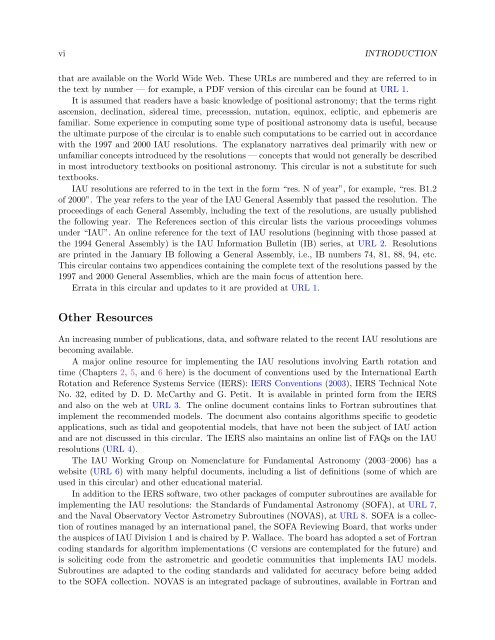USNO Circular 179 - U.S. Naval Observatory
USNO Circular 179 - U.S. Naval Observatory
USNO Circular 179 - U.S. Naval Observatory
Create successful ePaper yourself
Turn your PDF publications into a flip-book with our unique Google optimized e-Paper software.
vi INTRODUCTION<br />
that are available on the World Wide Web. These URLs are numbered and they are referred to in<br />
the text by number — for example, a PDF version of this circular can be found at URL 1.<br />
It is assumed that readers have a basic knowledge of positional astronomy; that the terms right<br />
ascension, declination, sidereal time, precesssion, nutation, equinox, ecliptic, and ephemeris are<br />
familiar. Some experience in computing some type of positional astronomy data is useful, because<br />
the ultimate purpose of the circular is to enable such computations to be carried out in accordance<br />
with the 1997 and 2000 IAU resolutions. The explanatory narratives deal primarily with new or<br />
unfamiliar concepts introduced by the resolutions — concepts that would not generally be described<br />
in most introductory textbooks on positional astronomy. This circular is not a substitute for such<br />
textbooks.<br />
IAU resolutions are referred to in the text in the form “res. N of year”, for example, “res. B1.2<br />
of 2000”. The year refers to the year of the IAU General Assembly that passed the resolution. The<br />
proceedings of each General Assembly, including the text of the resolutions, are usually published<br />
the following year. The References section of this circular lists the various proceedings volumes<br />
under “IAU”. An online reference for the text of IAU resolutions (beginning with those passed at<br />
the 1994 General Assembly) is the IAU Information Bulletin (IB) series, at URL 2. Resolutions<br />
are printed in the January IB following a General Assembly, i.e., IB numbers 74, 81, 88, 94, etc.<br />
This circular contains two appendices containing the complete text of the resolutions passed by the<br />
1997 and 2000 General Assemblies, which are the main focus of attention here.<br />
Errata in this circular and updates to it are provided at URL 1.<br />
Other Resources<br />
An increasing number of publications, data, and software related to the recent IAU resolutions are<br />
becoming available.<br />
A major online resource for implementing the IAU resolutions involving Earth rotation and<br />
time (Chapters 2, 5, and 6 here) is the document of conventions used by the International Earth<br />
Rotation and Reference Systems Service (IERS): IERS Conventions (2003), IERS Technical Note<br />
No. 32, edited by D. D. McCarthy and G. Petit. It is available in printed form from the IERS<br />
and also on the web at URL 3. The online document contains links to Fortran subroutines that<br />
implement the recommended models. The document also contains algorithms specific to geodetic<br />
applications, such as tidal and geopotential models, that have not been the subject of IAU action<br />
and are not discussed in this circular. The IERS also maintains an online list of FAQs on the IAU<br />
resolutions (URL 4).<br />
The IAU Working Group on Nomenclature for Fundamental Astronomy (2003–2006) has a<br />
website (URL 6) with many helpful documents, including a list of definitions (some of which are<br />
used in this circular) and other educational material.<br />
In addition to the IERS software, two other packages of computer subroutines are available for<br />
implementing the IAU resolutions: the Standards of Fundamental Astronomy (SOFA), at URL 7,<br />
and the <strong>Naval</strong> <strong>Observatory</strong> Vector Astrometry Subroutines (NOVAS), at URL 8. SOFA is a collection<br />
of routines managed by an international panel, the SOFA Reviewing Board, that works under<br />
the auspices of IAU Division 1 and is chaired by P. Wallace. The board has adopted a set of Fortran<br />
coding standards for algorithm implementations (C versions are contemplated for the future) and<br />
is soliciting code from the astrometric and geodetic communities that implements IAU models.<br />
Subroutines are adapted to the coding standards and validated for accuracy before being added<br />
to the SOFA collection. NOVAS is an integrated package of subroutines, available in Fortran and


